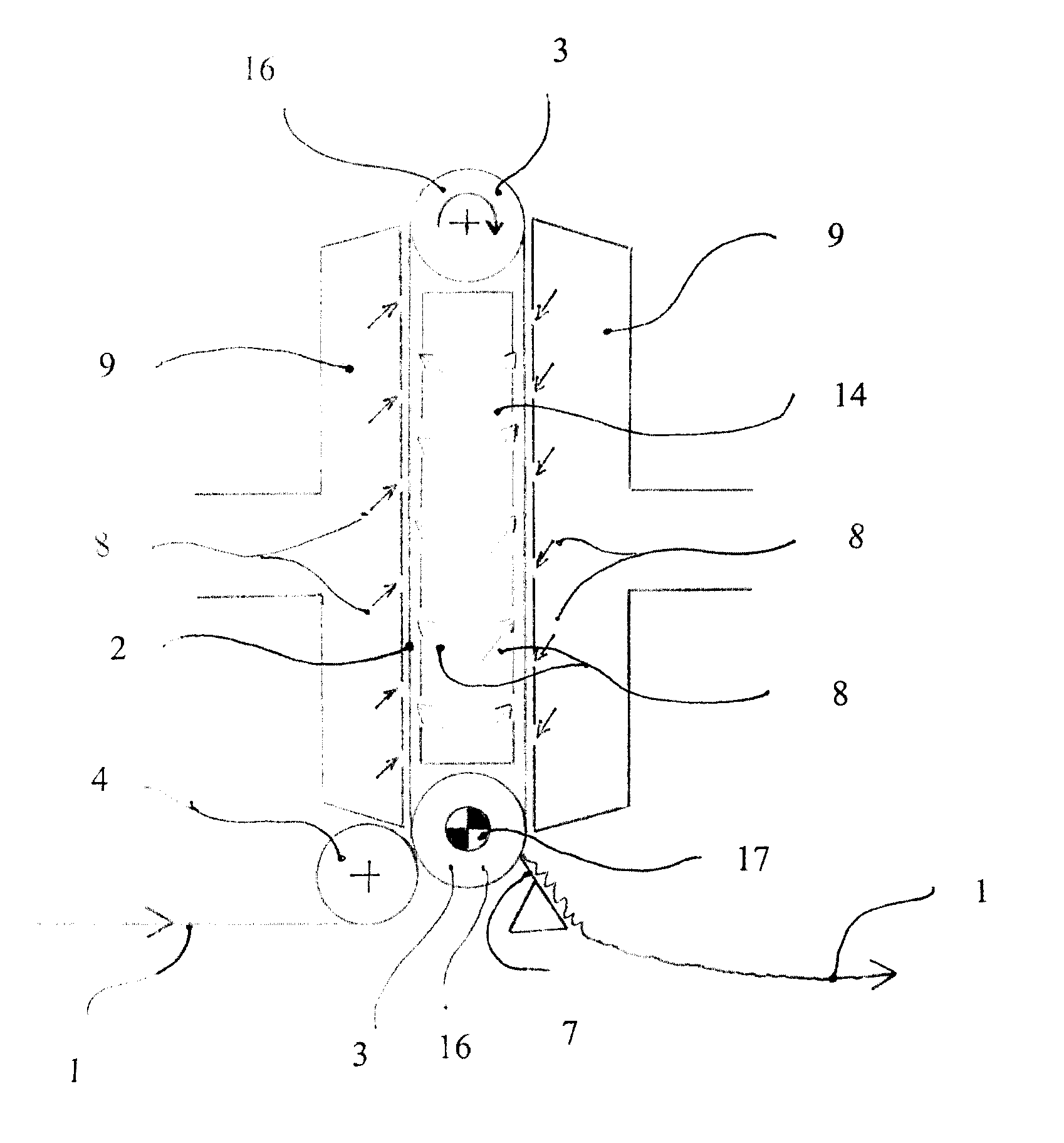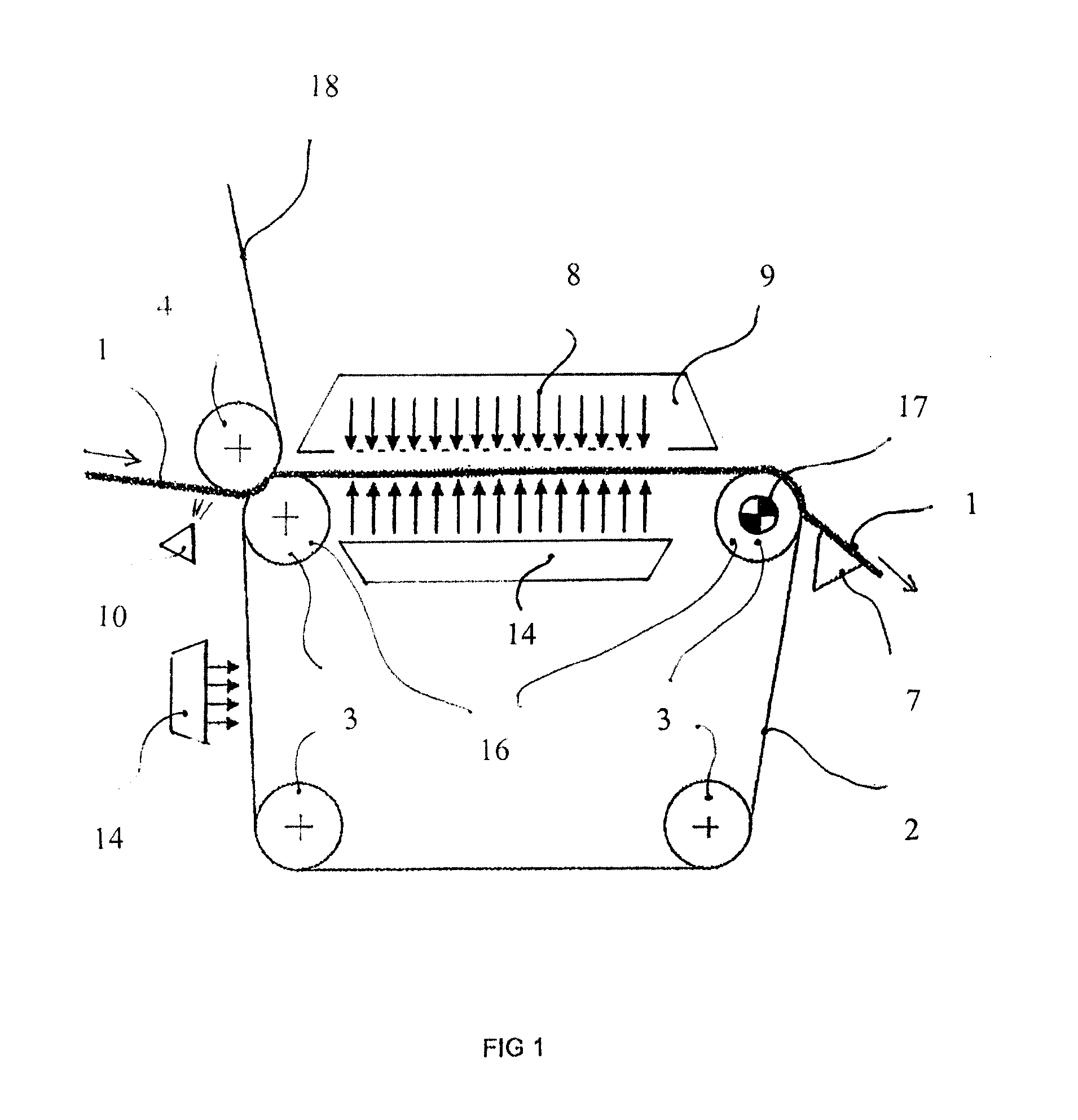Device for drying and treating a tissue paper web
a tissue paper and web technology, applied in the field of tissue paper web devices and fiber web production methods, can solve the problems of slow final drying, limited drying capacity of tissue machines, and inability to achieve the effect of reducing the cost of tissue paper production, and improving the quality of tissue paper products
- Summary
- Abstract
- Description
- Claims
- Application Information
AI Technical Summary
Benefits of technology
Problems solved by technology
Method used
Image
Examples
first embodiment
[0042]FIG. 1 shows the invention in which a metal belt 2 conveying a fiber web 1 is arranged rotatable via four rolls 3. In the figure, the delivery of the fiber web 1 is from the left supported by a fabric (e.g. a wire, a felt) to the device where the fiber web 1 transfers to be carried by the metal belt 2 via a nip formed by a pressure roll 4. The delivery of the fiber web 1 can be arranged such that the fiber web 1 is first supported on the shell of the pressure roll 4 directly or the fabric 18 being in between and, then supported by the shell, it transfers to the metal belt 2.
[0043]Before guiding the fiber web 1 to the nip, the fiber web 1 can be wet with a humidifier 10. After the nip, the combined draw of the fiber web 1 and the metal belt can be heated, even on both sides in accordance with the figure. Below the metal belt 2 is heated the metal belt 2, above the fiber web 1 is heated the actual fiber web 1 with air blowings. After the heating stage, the fiber web 1 conveyed b...
second embodiment
[0045]FIG. 2 shows the invention in which the metal belt cycle is arranged shorter of its principal dimensions in the horizontal direction (machine direction) than in the vertical direction. Thus, the horizontal principal dimension of the cycle of the metal belt 2 is smaller than the vertical principal dimension. The principal dimension refers to the distance between the rotation axes of the outermost rolls 3 in the metal belt cycle in the horizontal or vertical direction. In this arrangement, savings in space are considerable compared to previous in the arrangement based on the yankee cylinder. For heating the fiber web 1 is arranged at least one hood 9 outside the metal belt cycle, whereby the active heating area and travel become very effective. The metal belt cycle is implemented by means of two rolls 3. It is also possible to use three or four rolls 3, whereby the tightening and control operations of the metal belt 2 can be decentralized for different rolls 3. The detachment of...
third embodiment
[0049]FIG. 3 shows the invention in which the fiber web 1 is delivered from the right via a paper guide roll 13 into the nip formed by the metal belt 2 and the pressure roll 4. The fiber web 1 can be first delivered in contact with the metal belt 2 or the shell of the pressure roll 4 from which it is delivered into the nip. Before guiding the fiber web 1 to the nip, the fiber web 1 can be wet with the humidifier 10. Alternatively, moisturising can be applied on the surface of the metal belt 2. The delivery of the fiber web 1 can also be straight from the direction of the tangent to the nip. After the nip formed by the pressure roll 4, the fiber web 1 is supported by the metal belt 2 where it can be heated by means of a hood 9. The hood 9 is advantageously an impingement hood via which it is possible to blow hot air to intensify the drying. The hood 9 can surround the metal belt cycle curvilinearly past the second roll 3 from which the metal belt 2 rotates downwards onto the third ro...
PUM
 Login to View More
Login to View More Abstract
Description
Claims
Application Information
 Login to View More
Login to View More - R&D
- Intellectual Property
- Life Sciences
- Materials
- Tech Scout
- Unparalleled Data Quality
- Higher Quality Content
- 60% Fewer Hallucinations
Browse by: Latest US Patents, China's latest patents, Technical Efficacy Thesaurus, Application Domain, Technology Topic, Popular Technical Reports.
© 2025 PatSnap. All rights reserved.Legal|Privacy policy|Modern Slavery Act Transparency Statement|Sitemap|About US| Contact US: help@patsnap.com



